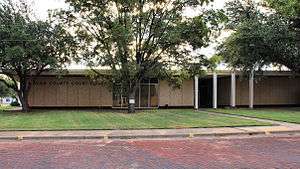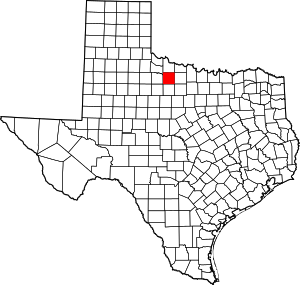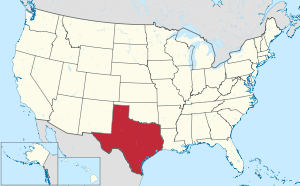Baylor County, Texas
Baylor County is a county located in the U.S. state of Texas. As of the 2010 census, its population was 3,726.[1] Its county seat is Seymour.[2] The county was created in 1858 and later organized in 1879.[3] It is named for Henry Weidner Baylor, a surgeon in the Texas Rangers during the Mexican–American War.
Baylor County | |
|---|---|
 The Baylor County Courthouse in Seymour | |
 Location within the U.S. state of Texas | |
 Texas's location within the U.S. | |
| Coordinates: 33°38′N 99°13′W | |
| Country | |
| State | |
| Founded | 1879 |
| Named for | Henry Weidner Baylor |
| Seat | Seymour |
| Largest city | Seymour |
| Area | |
| • Total | 901 sq mi (2,330 km2) |
| • Land | 867 sq mi (2,250 km2) |
| • Water | 34 sq mi (90 km2) 3.7%% |
| Population (2010) | |
| • Total | 3,726 |
| • Density | 4.3/sq mi (1.7/km2) |
| Time zone | UTC−6 (Central) |
| • Summer (DST) | UTC−5 (CDT) |
| Congressional district | 13th |
| Website | www |
Baylor County is not to be confused with Baylor University, which is located about 230 miles southeast in McLennan County, nor should its namesake be confused with Confederate Colonel George W. Baylor, who fought in Louisiana during the American Civil War.[4]
Baylor County is represented in the Texas House of Representatives by the Republican James Frank, a businessman from Wichita Falls.
Geography
According to the U.S. Census Bureau, the county has a total area of 901 square miles (2,330 km2), of which 867 square miles (2,250 km2) is land and 34 square miles (88 km2) (3.7%) is covered by water.[5]
Major highways





Adjacent counties
- Wilbarger County (north)
- Archer County (east)
- Throckmorton County (south)
- Knox County (west)
- Foard County (northwest)
- Wichita County (northeast)
- Haskell County (southwest)
- Young County (southeast)
Geology
Baylor County is part of the Texas Red Beds, which are a strata of red-colored sedimentary rock from the Early Permian. The fossils of Permian period vertebrates in the Texas Red Beds were first discovered by Edward Drinker Cope in 1877.[6][7] Subsequent research has revealed rare fossils of Permian-era amphibians like Trimerorhachis,[8] as well as rich deposits of other Permian tetrapods such as Dimetrodon and Diadectes.[9] Seymouria baylorensis, a species of Seymouria, was first discovered and named after Baylor County and the city of Seymour.[10]
Demographics
| Historical population | |||
|---|---|---|---|
| Census | Pop. | %± | |
| 1880 | 715 | — | |
| 1890 | 2,595 | 262.9% | |
| 1900 | 3,052 | 17.6% | |
| 1910 | 8,411 | 175.6% | |
| 1920 | 7,027 | −16.5% | |
| 1930 | 7,418 | 5.6% | |
| 1940 | 7,755 | 4.5% | |
| 1950 | 6,875 | −11.3% | |
| 1960 | 5,893 | −14.3% | |
| 1970 | 5,221 | −11.4% | |
| 1980 | 4,919 | −5.8% | |
| 1990 | 4,385 | −10.9% | |
| 2000 | 4,093 | −6.7% | |
| 2010 | 3,726 | −9.0% | |
| Est. 2019 | 3,509 | [11] | −5.8% |
| U.S. Decennial Census[12] 1850–2010[13] 2010–2014[1] | |||
As of the census[14] of 2000, 4,093 people, 1,791 households, and 1,156 families resided in the county. The population density was five people per square mile (2/km²). The 2,820 housing units averaged three per square mile (1/km²). The racial makeup of the county was 90.96% White, 3.35% Black or African American, 0.59% Native American, 0.51% Asian, 0.12% Pacific Islander, 3.32% from other races] and 1.15% from two or more races; 9.33% were Hispanic or Latino of any race.
Of the 1,791 households, 25.2% had children under the age of 18 residing in them, 53.5% were married couples living together, 8.2% had a female householder with no husband present, and 35.4% were not families. In addition, 33.30% of all households were made up of individuals and 19.2% had someone living alone who was 65 years of age or older. The average household size was 2.26 and the average family size was 2.86.
In the county, the population was distributed as 23.4% under the age of 18, 5.5% from 18 to 24, 21.4% from 25 to 44, 25.6% from 45 to 64, and 24.1% who were 65 years of age or older. The median age was 45 years. For every 100 females, there were 89.50 males. For every 100 females age 18 and over, there were 86.70 males.
The median income for a household in the county was $24,627, and for a family was $34,583. Males had a median income of $21,607 versus $19,571 for females. The per capita income for the county was $16,384. About 16.1% of the population and 12.9% of families were below the poverty line, and 26.3% of those under the age of 18 and 9% of those 65 and older were living below the poverty line.
Educational attainment
According to the 2000 census, 21.2% of those aged over 25 did not have a high school diploma, while 32.7% did. Roughly 8.7% of the population had a bachelor's degree, 2.3% had a master's degree, and 0.2% had a doctoral degree. No males had doctoral degrees, while 0.4% of females had one.
Education
Almost all of Baylor County is served by the Seymour Independent School District, which also serves portions of adjacent counties. A small portion is served by the Olney Independent School District. The OISD portion was served by the Megargel Independent School District until MISD closed after May 2006.
Politics
| Year | Republican | Democratic | Third parties |
|---|---|---|---|
| 2016 | 84.5%, 1,267 | 12.7%, 191 | 2.7%, 41 |
| 2012 | 81.5%, 1,297 | 16.8%, 267 | 1.8%, 28 |
| 2008 | 76.8%, 1,262 | 22.3%, 366 | 0.9%, 15 |
| 2004 | 71.3%, 1,169 | 28.5%, 467 | 0.2%, 4 |
| 2000 | 64.8%, 1,285 | 33.4%, 663 | 1.8% 36 |
| 1996 | 41.2%, 860 | 45.8%, 955 | 13.0%, 271 |
| 1992 | 28.7%, 611 | 46.4%, 990 | 24.9%, 531 |
| 1988 | 44.2%, 914 | 55.7%, 1,153 | 0.1% 3 |
| 1984 | 56.0%, 1,314 | 43.4%, 1,019 | 0.6%, 13 |
| 1980 | 47.6%, 1,098 | 51.3%, 1,183 | 1.1%, 25 |
| 1976 | 36.8%, 783 | 62.7%, 1,335 | 0.6%, 12 |
| 1972 | 66.5%, 1,190 | 33.4%, 598 | 0.1%, 1 |
| 1968 | 30.4%, 657 | 49.2%, 1,064 | 20.5%, 443 |
| 1964 | 21.7%, 389 | 78.2%, 1,403 | 0.1%, 2 |
| 1960 | 37.3% 713 | 62.7% 1,199 | 0.1% 1 |
| 1956 | 40.5% 715 | 59.3% 1,047 | 0.2% 4 |
| 1952 | 43.4% 879 | 56.4% 1,142 | 0.2% 3 |
| 1948 | 6.0% 101 | 90.8% 1,522 | 3.2% 53 |
| 1944 | 5.7% 102 | 87.7% 1,568 | 6.7% 119 |
| 1940 | 7.7% 139 | 92.3% 1,667 | 0.1% 1 |
| 1936 | 6.1% 100 | 93.9% 1,541 | 0.1% 1 |
| 1932 | 3.7% 55 | 96.3% 1,437 | 0.1% 1 |
| 1928 | 38.5% 491 | 61.5% 784 | |
| 1924 | 11.6% 135 | 87.0% 1,012 | 1.4% 16 |
| 1920 | 16.2% 139 | 73.6% 632 | 10.2% 88 |
| 1916 | 5.6% 47 | 85.1% 711 | 9.3% 78 |
| 1912 | 2.4% 15 | 89.3% 551 | 8.3% 51 |
See also
- Recorded Texas Historic Landmarks in Baylor County
References
- "State & County QuickFacts". United States Census Bureau. Archived from the original on December 1, 2015. Retrieved December 8, 2013.
- "Find a County". National Association of Counties. Archived from the original on July 4, 2012. Retrieved 2011-06-07.
- "Texas: Individual County Chronologies". Texas Atlas of Historical County Boundaries. The Newberry Library. 2008. Retrieved May 20, 2015.
- John D. Winters, The Civil War in Louisiana, Baton Rouge: Louisiana State University Press, 1963, ISBN 0-8071-0834-0, pp. 287–288. 364–365, 370–371
- "2010 Census Gazetteer Files". United States Census Bureau. August 22, 2012. Retrieved April 19, 2015.
- Cope, E. D. Descriptions of extinct vertebrata from the Permian and Triassic formations of the United States. Proceedings of the American Philosophical Society, 1877. Volume 17:182–195. JSTOR. Accessed on August 28, 2017.
- Case, E.C.The Red Beds between Wichita Falls, Texas, and Las Vegas, New Mexico, in Relation to Their Vertebrate Fauna. The Journal of Geology, vol. 22, no. 3, 1914, pp. 243–259. JSTOR. Accessed on August 28, 2017.
- Henry, Randy. NRCS and Landowner Team Up With Houston Museum after Rare Species Discovery. Natural Resources Conservation Service. Accessed on August 28, 2017.
- Caulfield, Dave. Prehistoric Predators: Fossil Findings in Seymour 'Redefining'. Newschannel 6: October 25, 2015. Accessed on August 28, 2017.
- Williston, S. W. Restoration of Seymouria Baylorensis Broili, an American Cotylosaur. The Journal of Geology: 1911, vol. 19, no. 3, pp. 232–237. JSTOR. Accessed on August 28, 2017.
- "Population and Housing Unit Estimates". United States Census Bureau. May 24, 2020. Retrieved May 27, 2020.
- "U.S. Decennial Census". United States Census Bureau. Retrieved April 19, 2015.
- "Texas Almanac: Population History of Counties from 1850–2010" (PDF). Texas Almanac. Retrieved April 19, 2015.
- "U.S. Census website". United States Census Bureau. Retrieved 2011-05-14.
- Leip, David. "Dave Leip's Atlas of U.S. Presidential Elections". uselectionatlas.org. Retrieved July 19, 2018.
External links
| Wikimedia Commons has media related to Baylor County, Texas. |
- Baylor County from the Handbook of Texas Online
- Baylor County from the Texas Almanac
- Baylor County from the TXGenWeb Project
- Baylor County Profile from the Texas Association of Counties
- Baylor County Website
